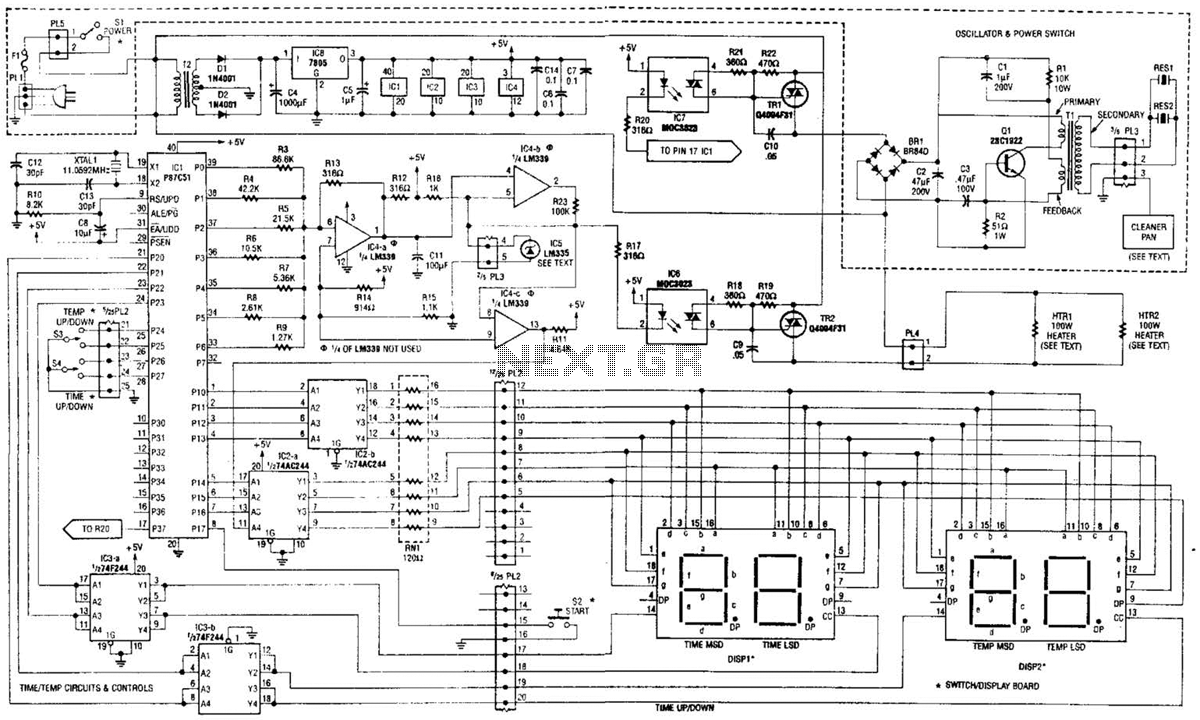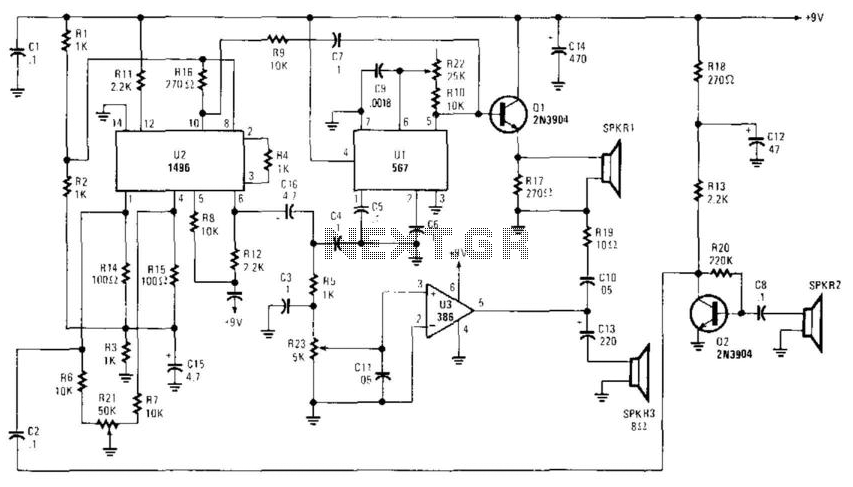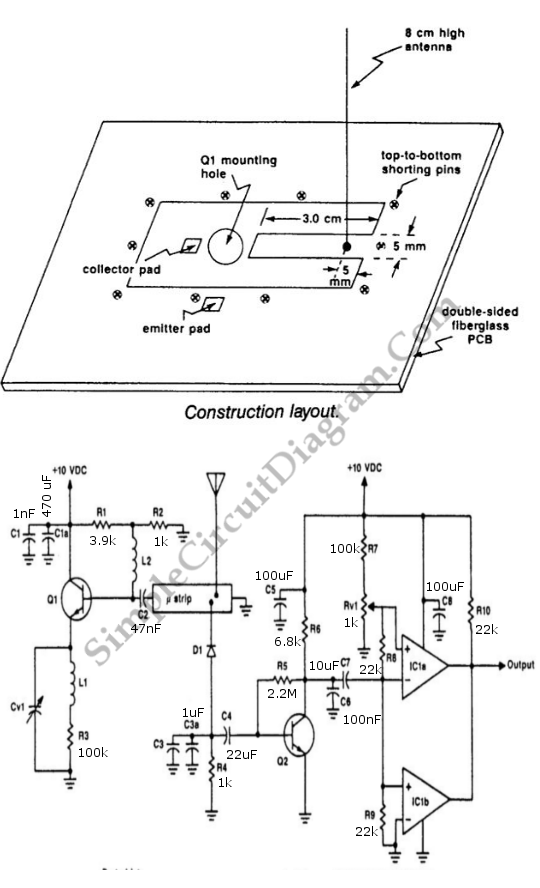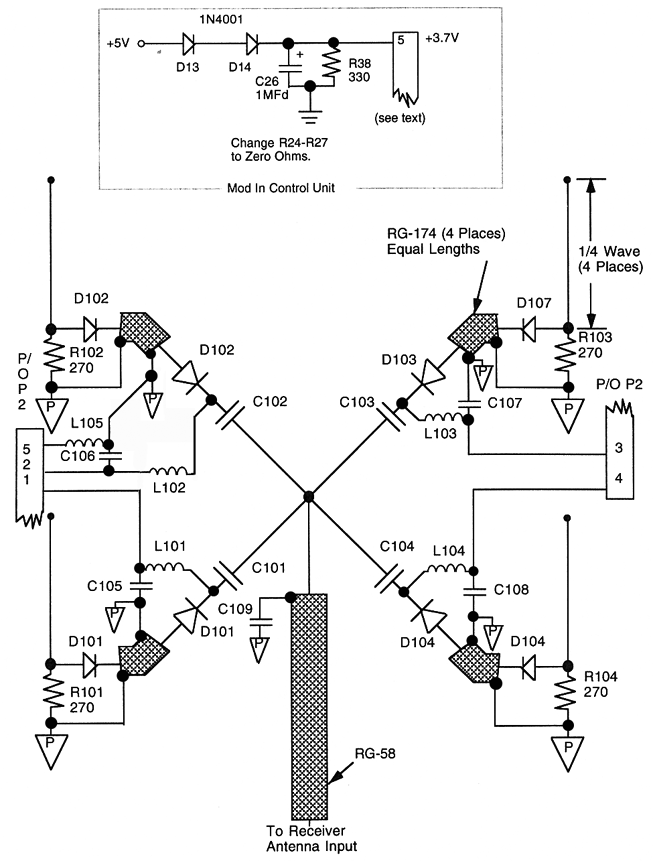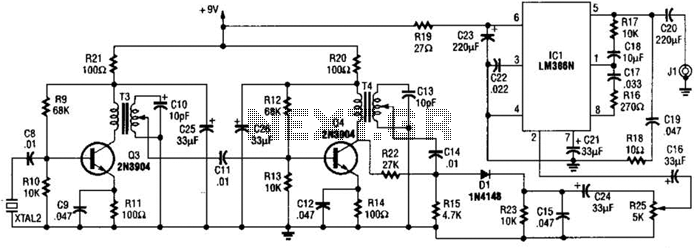
Doppler Rdf

The power supply consists of a 7812 voltage regulator followed by an operational amplifier (op-amp) configured to output 6V, which serves as a midpoint supply voltage for the audio op-amp stages. A 12V regulator is deemed excessive for battery-powered applications. Four outputs are connected to an op-amp configured as an integrator, with resistor-capacitor (R/C) circuitry surrounding these op-amps to ensure smooth transitions between stages. An antenna element is incorporated into the design. A network of two resistors biases the positive inputs of the op-amps; the voltage at these inputs influences the output waveforms, thereby affecting the transitions between antenna states. This aspect is crucial for proper functionality, as existing designs struggle with very low input signals, which fail to produce stable readings, while excessively high signals can clip during the final filtering stages, leading to significant bearing deviations. Consequently, the automatic gain control (AGC) in the PA8W Doppler system is an essential feature. It ensures that a steady audio signal, precisely at the target frequency, is minimally impacted by capacitors that have been previously charged to the appropriate voltage. Only audio components that deviate from the average will be significantly attenuated since the capacitors must adjust to the new voltage levels. Various parameters, including group delay in the receiver and phase shifts in the RDF low-pass filter stages, can distort this point of truth. The output of the NAND gate should be connected through a 3.3kΩ resistor to the base of the dimmer transistor, which provides Schmitt-trigger action for a clean "freeze" of the last bearing. When the AGC voltage falls below the "freezing point," the dimmer transistor's collector will rise, and the NAND gate's output will drop, preventing the 40174 from being retriggered. A straightforward method for proper adjustment involves turning the sensitivity fully clockwise (with no input signal) and then gradually rotating it counterclockwise until the pelorus freezes.
The circuit design incorporates a 7812 voltage regulator, which provides a stable 12V output that is then stepped down to 6V through an operational amplifier configured for this purpose. This ensures that the audio stages receive a reliable midpoint voltage, crucial for optimal performance in battery-operated scenarios. The use of an integrator configuration for the op-amps allows for the smoothing of signals, minimizing abrupt changes that could lead to instability in the output.
The biasing network of two resistors is strategically placed to set the correct voltage levels at the positive inputs of the op-amps. This biasing is vital as it directly influences the output waveforms, ensuring that transitions between antenna states occur smoothly and without distortion. The design addresses the common issue seen in previous iterations where low input signals resulted in unstable readings and high signals caused clipping, which could severely impact the accuracy of the system.
The integration of automatic gain control (AGC) enhances the system's ability to maintain a consistent output despite varying input levels. This feature is particularly beneficial in filtering out noise while preserving the integrity of signals that are close to the target frequency. The capacitors in the circuit play a critical role in this process by adapting to the voltage levels over time, allowing for only significant deviations to be adjusted, thus maintaining the overall stability of the audio output.
Furthermore, the connection of the NAND gate output to the dimmer transistor via a 3.3kΩ resistor introduces Schmitt-trigger behavior, which is essential for providing a clean transition during the "freeze" state of the bearing. This mechanism ensures that fluctuations in the AGC voltage do not inadvertently trigger the retriggering of the 40174, thus preserving the accuracy of the readings. The adjustment of sensitivity is a user-friendly feature, allowing for fine-tuning without the need for complex recalibrations, simply by manipulating the sensitivity control until the desired "freeze" effect is achieved.
Overall, this circuitry design emphasizes stability, adaptability, and user-friendliness, making it suitable for applications requiring precise audio signal processing and reliable performance in varying conditions.The power supply is just a 7812 voltage regulator followed by an op-amp set to 6V to create a half way supply voltage for the audio op-amp stages. A 12V regulator seems to be too high for a battery fed application. These 4 outputs are all followed by a op-amp set up as an integrator. and the R/C circuitry around these op-amps ensure a very soft transition to the next antenna element. A network of two resistors feeding the + inputs of the op-amps is used to bias the op-amps; the voltage on the + inputs is determining the output waveforms and therefore the resulting transition from one to the next antenna. This is quite important for normal operation; in existing designs very small input signals will not give a stable reading, and signals that are too big will clip in the last filter stages resulting in serious bearing deviations.
Therefore, the automatic gain control in the PA8W Doppler is a valuable addition. That means that a constant audio signal exactly on frequency will hardly be affected by the capacitors that will already have been charged to the right voltage over some time. Only parts in the audio that deviate from average will be reduced extremely because the capacitors will have to be charged or discharged to the new value.
All kinds of parameters, such as group delay in your receiver and phase shift in the RDF low pass filter stages will shift this point away from the truth, The output of the NAND poort should be connected via the 3M3 resistor to the base of the dimmer transistor to provide some schmitt-trigger action for a clean "freeze" of the last bearing. As soon as the AGC voltage is dropping below the "freezing point" the collector of the dimmer transistor will go up and the output of the NAND will go down, preventing the 40174 to be retriggered.
A simple way to adjust it correctly is by turning sensitivity fully clockwise (with no input signal!) and then slowly turning it counterclockwise until the pelorus freezes. 🔗 External reference
The circuit design incorporates a 7812 voltage regulator, which provides a stable 12V output that is then stepped down to 6V through an operational amplifier configured for this purpose. This ensures that the audio stages receive a reliable midpoint voltage, crucial for optimal performance in battery-operated scenarios. The use of an integrator configuration for the op-amps allows for the smoothing of signals, minimizing abrupt changes that could lead to instability in the output.
The biasing network of two resistors is strategically placed to set the correct voltage levels at the positive inputs of the op-amps. This biasing is vital as it directly influences the output waveforms, ensuring that transitions between antenna states occur smoothly and without distortion. The design addresses the common issue seen in previous iterations where low input signals resulted in unstable readings and high signals caused clipping, which could severely impact the accuracy of the system.
The integration of automatic gain control (AGC) enhances the system's ability to maintain a consistent output despite varying input levels. This feature is particularly beneficial in filtering out noise while preserving the integrity of signals that are close to the target frequency. The capacitors in the circuit play a critical role in this process by adapting to the voltage levels over time, allowing for only significant deviations to be adjusted, thus maintaining the overall stability of the audio output.
Furthermore, the connection of the NAND gate output to the dimmer transistor via a 3.3kΩ resistor introduces Schmitt-trigger behavior, which is essential for providing a clean transition during the "freeze" state of the bearing. This mechanism ensures that fluctuations in the AGC voltage do not inadvertently trigger the retriggering of the 40174, thus preserving the accuracy of the readings. The adjustment of sensitivity is a user-friendly feature, allowing for fine-tuning without the need for complex recalibrations, simply by manipulating the sensitivity control until the desired "freeze" effect is achieved.
Overall, this circuitry design emphasizes stability, adaptability, and user-friendliness, making it suitable for applications requiring precise audio signal processing and reliable performance in varying conditions.The power supply is just a 7812 voltage regulator followed by an op-amp set to 6V to create a half way supply voltage for the audio op-amp stages. A 12V regulator seems to be too high for a battery fed application. These 4 outputs are all followed by a op-amp set up as an integrator. and the R/C circuitry around these op-amps ensure a very soft transition to the next antenna element. A network of two resistors feeding the + inputs of the op-amps is used to bias the op-amps; the voltage on the + inputs is determining the output waveforms and therefore the resulting transition from one to the next antenna. This is quite important for normal operation; in existing designs very small input signals will not give a stable reading, and signals that are too big will clip in the last filter stages resulting in serious bearing deviations.
Therefore, the automatic gain control in the PA8W Doppler is a valuable addition. That means that a constant audio signal exactly on frequency will hardly be affected by the capacitors that will already have been charged to the right voltage over some time. Only parts in the audio that deviate from average will be reduced extremely because the capacitors will have to be charged or discharged to the new value.
All kinds of parameters, such as group delay in your receiver and phase shift in the RDF low pass filter stages will shift this point away from the truth, The output of the NAND poort should be connected via the 3M3 resistor to the base of the dimmer transistor to provide some schmitt-trigger action for a clean "freeze" of the last bearing. As soon as the AGC voltage is dropping below the "freezing point" the collector of the dimmer transistor will go up and the output of the NAND will go down, preventing the 40174 to be retriggered.
A simple way to adjust it correctly is by turning sensitivity fully clockwise (with no input signal!) and then slowly turning it counterclockwise until the pelorus freezes. 🔗 External reference

